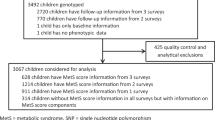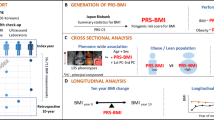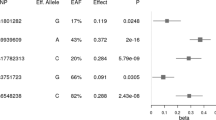Abstract
Background:
Genetic variants that predispose individuals to obesity may have differing influences during childhood versus adulthood, and additive effects of such variants are likely to occur. Our ongoing studies to identify genetic determinants of obesity in American Indians have identified 67 single-nucleotide polymorphisms (SNPs) that reproducibly associate with maximum lifetime non-diabetic body mass index (BMI). This study aimed to identify when, during the lifetime, these variants have their greatest impact on BMI increase.
Subjects/Methods:
A total of 5906 Native Americans of predominantly Pima Indian heritage with repeated measures of BMI between the ages of 5 and 45 years were included in this study. The association between each SNP with the rates of BMI increase during childhood (5–19 years) and adulthood (20–45 years) were assessed separately. The significant SNPs were used to calculate a cumulative allelic risk score (ARS) for childhood and adulthood, respectively, to assess the additive effect of these variants within each period of life.
Results:
The majority of these SNPs (36 of 67) were associated with rate of BMI increase during childhood (P-value range: 0.00004–0.05), whereas only nine SNPs were associated with rate of BMI change during adulthood (P-value range: 0.002–0.02). These 36 SNPs associated with childhood BMI gain likely had a cumulative effect as a higher childhood-ARS associated with rate of BMI change (β=0.032 kg m−2 per year per risk allele, 95% confidence interval: 0.027–0.036, P<0.0001), such that at age 19 years, individuals with the highest number of risk alleles had a BMI of 10.2 kg m−2 greater than subjects with the lowest number of risk alleles.
Conclusions:
Overall, our data indicates that genetic polymorphisms associated with lifetime BMI may influence the rate of BMI increase during different periods in the life course. The majority of these polymorphisms have a larger impact on BMI during childhood, providing further evidence that prevention of obesity will need to begin early in life.
This is a preview of subscription content, access via your institution
Access options
Subscribe to this journal
Receive 12 print issues and online access
$259.00 per year
only $21.58 per issue
Buy this article
- Purchase on Springer Link
- Instant access to full article PDF
Prices may be subject to local taxes which are calculated during checkout




Similar content being viewed by others
References
Adams KF, Schatzkin A, Harris TB, Kipnis V, Mouw T, Ballard-Barbash R et al. Overweight, obesity, and mortality in a large prospective cohort of persons 50 to 71 years old. N Engl J Med 2006; 355: 763–778.
Berrington de Gonzalez A, Hartge P, Cerhan JR, Flint AJ, Hannan L, MacInnis RJ et al. Body-mass index and mortality among 1.46 million white adults. N Engl J Med 2010; 363: 2211–2219.
Zheng W, McLerran DF, Rolland B, Zhang X, Inoue M, Matsuo K et al. Association between body-mass index and risk of death in more than 1 million Asians. N Engl J Med 2011; 364: 719–729.
Chen Z, Yang G, Offer A, Zhou M, Smith M, Peto R et al. Body mass index and mortality in China: a 15-year prospective study of 220 000 men. Int J Epidemiol 2012; 41: 472–481.
de Mutsert R, Sun Q, Willett WC, Hu FB, van Dam RM . Overweight in early adulthood, adult weight change, and risk of type 2 diabetes, cardiovascular diseases, and certain cancers in men: a cohort study. Am J Epidemiol 2014; 179: 1353–1365.
Borrell LN, Samuel L . Body mass index categories and mortality risk in us adults: the effect of overweight and obesity on advancing death. Am J Public Health 2014; 104: 512–519.
Twig G, Afek A, Shamiss A, Derazne E, Landau Rabbi M, Tzur D et al. Adolescence BMI and trends in adulthood mortality: a study of 2.16 million adolescents. J Clin Endocrinol Metab 2014; 99: 2095–2103.
Freedman DS, Khan LK, Serdula MK, Dietz WH, Srinivasan SR, Berenson GS . The relation of childhood BMI to adult adiposity: the Bogalusa Heart Study. Pediatrics 2005; 115: 22–27.
Han JC, Lawlor DA, Kimm SY . Childhood obesity. Lancet 2010; 375: 1737–1748.
Malhotra R, Ostbye T, Riley CM, Finkelstein EA . Young adult weight trajectories through midlife by body mass category. Obesity (Silver Spring) 2013; 21: 1923–1934.
Klenk J, Rapp K, Ulmer H, Concin H, Nagel G . Changes of body mass index in relation to mortality: results of a cohort of 42,099 adults. PLoS One 2014; 9: e84817.
Tj P, CP, Summerbell CD . Childhood predictors of adult obesity: a systematic review. Int J Obes Relat Metab Disord J Int Assoc Study Obes 1999; 23 (Suppl 8): S1–107.
Maes HHM, Neale MC, Eaves LJ . Genetic and environmental factors in relative body weight and human adiposity. Behav Genet 1997; 27: 325–351.
Haworth CMA, Carnell S, Meaburn EL, Davis OSP, Plomin R, Wardle J . Increasing heritability of BMI and stronger associations with the FTO gene over childhood. Obesity 2008; 16: 2663–2668.
Speliotes EK, Willer CJ, Berndt SI, Monda KL, Thorleifsson G, Jackson AU et al. Association analyses of 249,796 individuals reveal 18 new loci associated with body mass index. Nat Genet 2010; 42: 937–948.
Loos RJF, Lindgren CM, Li S, Wheeler E, Zhao JH, Prokopenko I et al. Common variants near MC4R are associated with fat mass, weight and risk of obesity. Nat Genet 2008; 40: 768–775.
Thorleifsson G, Walters GB, Gudbjartsson DF, Steinthorsdottir V, Sulem P, Helgadottir A et al. Genome-wide association yields new sequence variants at seven loci that associate with measures of obesity. Nat Genet 2009; 41: 18–24.
Willer CJ, Speliotes EK, Loos RJF, Li S, Lindgren CM, Heid IM et al. Six new loci associated with body mass index highlight a neuronal influence on body weight regulation. Nat Genet 2009; 41: 25–34.
Elks CE, Loos RJF, Hardy R, Wills AK, Wong A, Wareham NJ et al. Adult obesity susceptibility variants are associated with greater childhood weight gain and a faster tempo of growth: the 1946 British Birth Cohort Study. Am J Clin Nutr 2012; 95: 1150–1156.
Elks CE, Loos RJF, Sharp SJ, Langenberg C, Ring SM, Timpson NJ et al. Genetic markers of adult obesity risk are associated with greater early infancy weight gain and growth. PLoS Med 2010; 7: e1000284.
Xi B, Cheng H, Shen Y, Chandak GR, Zhao X, Hou D et al. Study of 11 BMI-associated loci identified in GWAS for associations with central obesity in the Chinese children. PLoS One 2013; 8: e56472.
Hardy R, Wills AK, Wong A, Elks CE, Wareham NJ, Loos RJF et al. Life course variations in the associations between FTO and MC4R gene variants and body size. Hum Mol Genet 2010; 19: 545–552.
Kilpeläinen TO, den Hoed M, Ong KK, Grøntved A, Brage S et al, Early Growth Genetics Consortium. Obesity-susceptibility loci have a limited influence on birth weight: a meta-analysis of up to 28,219 individuals. Am J Clin Nutr 2011; 93: 851–860.
Andersson EA, Pilgaard K, Pisinger C, Harder MN, Grarup N, Færch K et al. Do gene variants influencing adult adiposity affect birth weight? A population-based study of 24 loci in 4,744 Danish individuals. PLoS One 2010; 5: e14190.
Thearle MS, Muller YL, Hanson RL, Mullins M, Abdussamad M, Tran J et al. Greater impact of melanocortin-4 receptor deficiency on rates of growth and risk of type 2 diabetes during childhood compared with adulthood in pima indians. Diabetes 2012; 61: 250–257.
Votruba SB, Thearle MS, Piaggi P, Knowler WC, Hanson RL, Krakoff J . Weight maintenance from young adult weight predicts better health outcomes. Obesity (Silver Spring) 2014; 22: 2361–2369.
Traurig M, Perez J, Ma L, Bian L, Kobes S, Hanson RL et al. Variants in the LEPR gene are nominally associated with higher BMI and lower 24 hour energy expenditure in Pima Indians. Obesity (Silver Spring) 2012; 20: 2426–2430.
Traurig M, Mack J, Hanson RL, Ghoussaini M, Meyre D, Knowler WC et al. Common variation in SIM1 is reproducibly associated with BMI in Pima Indians. Diabetes 2009; 58: 1682–1689.
Hanson RL, Guo T, Muller YL, Fleming J, Knowler WC, Kobes S et al. Strong parent-of-origin effects in the association of KCNQ1 variants with type 2 diabetes mellitus in American Indians. Diabetes 2013; 62: 2984–2991.
Rong R, Hanson RL, Ortiz D, Wiedrich C, Kobes S, Knowler WC et al. Association analysis of variation in/near FTO, CDKAL1, SLC30A8, HHEX, EXT2, IGF2BP2, LOC387761 and CDKN2B with type 2 diabetes and related quantitative traits in Pima Indians. Diabetes 2008; 58: 478–488.
Guo T, Hanson RL, Traurig M, Muller YL, Ma L, Mack J et al. TCF7L2 is not a major susceptibility gene for type 2 diabetes in Pima Indians: an analysis of 3501 individuals. Diabetes 2007; 56: 3082–3088.
Bian L, Traurig M, Hanson RL, Marinelarena A, Kobes S, Muller YL et al. MAP2K3 is associated with body mass index in American Indians and Caucasians and may mediate hypothalamic inflammation. Hum Mol Genet 2013; 22: 4438–4449.
Traurig MT, Orczewska JI, Ortiz DJ, Bian L, Marinelarena AM, Kobes S et al. Evidence for a role of LPGAT1 in influencing BMI and percent body fat in Native Americans. Obesity (Silver Spring) 2013; 21: 193–202.
Huang K, Nair AK, Muller YL, Piaggi P, Bian L, del Rosario M et al. Whole exome sequencing identifies variation in CYB5A and RNF10 associated with adiposity and type 2 diabetes. Obesity 2014; 22: 984–988.
Knowler WC, Pettitt DJ, Saad MF, Charles MA, Nelson RG, Howard BV et al. Obesity in the Pima Indians: its magnitude and relationship with diabetes. Am J Clin Nutr 1991; 53: 1543S–1551S.
Lindsay RS, Hanson RL, Bennett PH, Knowler WC . Secular trends in birth weight, BMI, and diabetes in the offspring of diabetic mothers. Diabetes Care 2000; 23: 1249–1254.
American Diabetes Association. Diagnosis and classification of diabetes mellitus. Diabetes Care 2010; 33: S62–S69.
Tataranni PA, Ravussin E . Use of dual-energy X-ray absorptiometry in obese individuals. Am J Clin Nutr 1995; 62: 730.
Ma L, Tataranni PA, Bogardus C, Baier LJ . Melanocortin 4 receptor gene variation is associated with severe obesity in Pima Indians. Diabetes 2004; 53: 2696–2699.
Muller YL, Thearle MS, Piaggi P, Hanson RL, Hoffman D, Gene B et al. Common genetic variation in and near the melanocortin 4 receptor gene (MC4R) is associated with body mass index in American Indian adults and children. Hum Genet 2014; 133: 1431–1441.
Muller YL, Piaggi P, Hoffman D, Huang K, Gene B, Kobes S et al. Common genetic variation in the glucokinase gene (GCK) is associated with type 2 diabetes and rates of carbohydrate oxidation and energy expenditure. Diabetologia 2014; 57: 1382–1390.
Muller YL, Piaggi P, Hanson RL, Kobes S, Bhutta S, Abdussamad M et al. A cis-eQTL in PFKFB2 is associated with diabetic nephropathy, adiposity and insulin secretion in American Indians. Hum Mol Genet 2015; 24: 2985–2996.
Tian C, Hinds DA, Shigeta R, Adler SG, Lee A, Pahl MV et al. A genomewide single-nucleotide-polymorphism panel for Mexican American admixture mapping. Am J Hum Genet 2007; 80: 1014–1023.
WHO Expert Consultation. Appropriate body-mass index for Asian populations and its implications for policy and intervention strategies. Lancet 2004; 363: 157–163.
Belsky DW, Moffitt TE, Houts R, Bennett GG, Biddle AK, Blumenthal JA et al. Polygenic risk, rapid childhood growth, and the development of obesity: evidence from a 4-decade longitudinal study. Arch Pediatr Adolesc Med 2012; 166: 515–521.
Bell CG, Walley AJ, Froguel P . The genetics of human obesity. Nat Rev Genet 2005; 6: 221–234.
Neel JV . Diabetes mellitus: a ‘thrifty’ genotype rendered detrimental by ‘progress’? Am J Hum Genet 1962; 14: 353–362.
Farooqi IS, Keogh JM, Yeo GSH, Lank EJ, Cheetham T, O’Rahilly S . Clinical spectrum of obesity and mutations in the melanocortin 4 receptor gene. N Engl J Med 2003; 348: 1085–1095.
Hoed M, den, Ekelund U, Brage S, Grontved A, Zhao JH, Sharp SJ et al. Genetic susceptibility to obesity and related traits in childhood and adolescence influence of loci identified by genome-wide association studies. Diabetes 2010; 59: 2980–2988.
Acknowledgements
We gratefully acknowledge the help of the nursing staff, physician assistants, laboratory technicians and dietary staffs of all three branches of the National Institute of Diabetes, Digestive and Kidney Disease in Phoenix, AZ, USA. Most of all, we thank the volunteers for their participation in the studies. This work was supported by the Intramural Research Program of the National Institutes of Health, National Institute of Diabetes and Digestive and Kidney Diseases. Study protocols are registered under ClinicalTrials.gov: NCT00339482 and NCT00340132.
AUTHOR CONTRIBUTIONS
MGH was involved in the study design, data analysis and interpretation and writing of the manuscript; LJB and YLM were involved in the data collection, interpretation and revision of the manuscript; PP was involved in the data analysis and revision of the manuscript; RLH was involved in the data collection and data analysis; JK was involved in the data collection, interpretation and review of the manuscript; MST was involved in the study design, data analysis, data interpretation, review and revision of the manuscript.
Author information
Authors and Affiliations
Corresponding author
Ethics declarations
Competing interests
The authors declare no conflict of interest.
Additional information
Supplementary Information accompanies this paper on International Journal of Obesity website
Supplementary information
Rights and permissions
About this article
Cite this article
Hohenadel, M., Baier, L., Piaggi, P. et al. The impact of genetic variants on BMI increase during childhood versus adulthood. Int J Obes 40, 1301–1309 (2016). https://doi.org/10.1038/ijo.2016.53
Received:
Revised:
Accepted:
Published:
Issue Date:
DOI: https://doi.org/10.1038/ijo.2016.53



